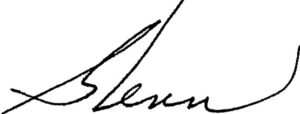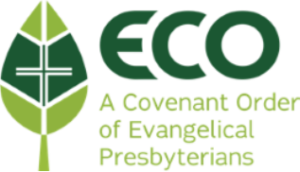“AS GLENN SEES IT!”
A BRIEF HISTORY OF THE FOUNTAIN HILLS
PRESBYTERIAN CHURCH
FOUNTAIN HILLS, ARIZONA
BY
GLENN A. ATCHINSON, FOUNDING PASTOR
1974 – 1998
It was not totally by accident that I drove into Fountain Hills as a New Church Development Pastor in January of 1974. It started two years before when I came to Arizona to perform a wedding ceremony for my brother, Tony Atchinson, and his bride to be, Sally Ballee. Sally and her two children were the first permanent residents to move into Fountain Hills, so this raw community was the first place I visited in Arizona.
Moving to Arizona, I lived and worked in Apache Junction doing youth and young family’s ministries with the John Calvin Presbyterian Church. When that assignment was completed, I approached the Presbytery of Grand Canyon with a proposal that I spend time in Fountain Hills to determine if a congregation might be started here. I was given three months to do the task with the promise that I would be one of those interviewed for the position if I proved a church was possible.
I gathered the demographic data quickly and spent the rest of my time just talking with people in restaurants and businesses. By the end of February, a group of 12 persons, with whom I had become acquainted and were interested in a new church, met in the Fountain Hills home of Dick and Joyce Hartley. That evening they all made a commitment to work with me if Presbytery approved the idea. The following month Presbytery approved the project, allotted a budget of 18,000 and had the courage to hire me as New Church Development Pastor.
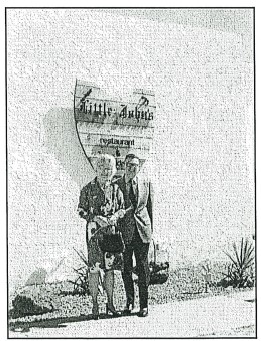 The first challenge was to find a meeting place. There were no buildings available even if we had the money to rent one. Dick Hartley and I visited the owner of Little John’s, a bar/restaurant recently opened, and asked if we might use the place for services on Sunday mornings. Tom Colosimo, the owner, not only agreed but offered it free of cost, including his coffee.
The first challenge was to find a meeting place. There were no buildings available even if we had the money to rent one. Dick Hartley and I visited the owner of Little John’s, a bar/restaurant recently opened, and asked if we might use the place for services on Sunday mornings. Tom Colosimo, the owner, not only agreed but offered it free of cost, including his coffee.
The first service was held on March 31, 1974 with 60 people in attendance, many of them my friends and relatives. We sat around tables of four or eight, much as “ they are arranged today in the restaurant Que Bueno.
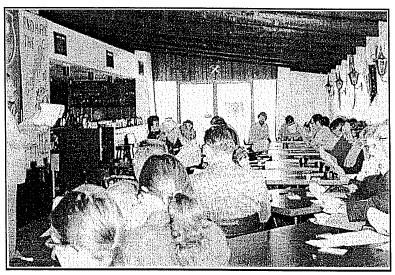 Music was from tapes which I had made at various Churches in the Valley.
Music was from tapes which I had made at various Churches in the Valley.
Starting in such a place set the character of our congregation. Those who were too uptight to worship God in a bar didn’t come. Those who came were folks free enough in their faith to worship anywhere! The style of a people free, open and accepting continues to be the character of this congregation.
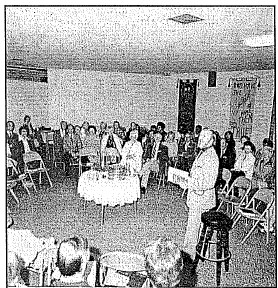 September revealed that Little John’s was too small for our gatherings. The group, led by Larry Ryerson, an early member of the fellowship, negotiated a lease agreement for our exclusive use of a 2,500 square foot building on Enterprise Drive. After renovations, completed by the people of the fellowship, the new church development moved into the space on the first Sunday of October, World Communion Sunday. Our Church remained there until moving to our Campus in 1983.
September revealed that Little John’s was too small for our gatherings. The group, led by Larry Ryerson, an early member of the fellowship, negotiated a lease agreement for our exclusive use of a 2,500 square foot building on Enterprise Drive. After renovations, completed by the people of the fellowship, the new church development moved into the space on the first Sunday of October, World Communion Sunday. Our Church remained there until moving to our Campus in 1983.
On our last Sunday at Little John’s, Tom Colosimo came into the service and ceremoniously presented me with one of his bar stools, saying, “You’ve used this as your preaching stool for the last six months, I think you should take it with you.” That stool remains as an Icon of the flexibility of this congregation. For years, there were only five stools at a six-stool bar at Little John’s. It was announced, “The Presbyterians have the other one.”
By November the group working on the development of the Church had collected 63 signatures of potential charter members. After making a presentation at the November Presbytery meeting, permission was granted for the congregation to organize as a United Presbyterian Church. The legal name would be “The United Presbyterian Church in Fountain Hills.”
The chartering service was held on Advent Sunday, December 1, 1974. Members of the Synod of the Southwest and the Presbytery of the Grand Canyon were on hand for the event, including the Rev. Robert Chapman, our Presbytery Executive and a strong supporter of our efforts. A part of the chartering included the election of our first Session. Among them were Harlan Collins and Earl Stavely, both still active members of our Church. The new organization started with $616.91 in the General Fund and $198.21 in a Building Fund, with all current bills paid.
One of the most memorable services of 1974 was the Christmas Eve Service. Having no idea how many might come, we prepared for 90 people. That was the number of little communion cups our trays would hold. During the serving of the Sacramental bread, one of the elders turned to me with a shrug of his shoulders, letting me know there wasn’t enough pieces to go around. I said to the congregation of 130, “We have a problem not unlike one Jesus had. It will be interesting to see how it is solved!” Without hesitation those in the front rows, holding their bread, broke the bread and passed it to the back. When the elders returned the plates to the table, there was bread left over, a miracle of sharing.
Nineteen seventy-five was a year of figuring out who we were and what would be our goals. One of those goals was to be active in the development of the community of Fountain Hills. The Session joined the newly formed Chamber of Commerce as a witness of our involvement. Ours was the first Church member of the Chamber and we remain a member to this day. The congregation also had a great interest in education and appointed a committee, headed by Ann Stavely, to monitor the new Fountain Hills School District. We were the instigators of an initiative to change the composition of the School Board from three to the present five members.
The Session also moved to incorporate our Church as an Arizona nonprofit Corporation. The legal world was done by the Presbytery attorney, Tom Wade, who later became a member of our Church.
My status was changed from Designated Pastor to Called Pastor after a Pastor Nominating Committee, headed by Peg Tibbetts, recommended my election at a Congregational Meeting in September. The Installation Service tools place October 12, 1975, with the Presbytery of Grand Canyon conducting the installation. Though not a Presbyterian, the denomination was kind enough to include my mother, Katherine Atchinson, as a member of the Installation Commission.
The following year, 1976, was filled with concerns about growth and money. The grant from the Presbytery was reduced each year and the members needed to take more of the slack. To help with the increasing responsibilities, the congregation voted to increase the size of the Session from six members to nine members. Beyond the regular work in the congregation, I was spending nearly a fourth of my time as community counselor with at least 50 percent of the people being nonmembers. You have to remember these were crazy times for this new community.
Nineteen seventy-seven brought new growth challenges to this emerging congregation. Up to now we had only a borrowed organ for our music. My siblings, Molly Pitcher, Dale, Tony and Ray Atchinson gifted our Church with monies to purchase our own piano. The gift was given in memory of my beloved Father, Milfred Atchinson. It is still in use in the Program Center.
The congregation was restless to buy a site for a future Church Campus. The Session approached the developer, McCulloch Properties, Inc., about the site we now occupy and were told it was unavailable. Rumor was that McCulloch was being turned over to Pratt Properties, so we decided to wait until that occurred and try again. That we did! And after hounding Loren Pratt on a weekly schedule, he said to me, “All right! Go step off what you want and we’ll sell it to you.”
At a meeting in June 1978, it was voted, “That Session be authorized to negotiate with PPI and consummate purchase of the described property on the best possible terms, contingent upon satisfactory financing being obtained.” The five-acre site was purchased for $87,000 with the help of a $50,000 loan from the General Assembly, a $24,000 loan from the Synod of the Southwest and cash of $13,000 raised from the congregation. We were now a part of mainstream America with debts and hopes.
The congregation opened Children’s Village Preschool in September of 1978, continuing this community ministry until 1984 when the school was given to Christ’s Church, who took over the Enterprise building when our campus opened.
Our first fund raising challenge came in 1979 in a “Pledge for Progress” fund’s campaign to pay for our site. Ann Stavely was Chair of this successful endeavor, with the help of a denominational campaign director. As an off shoot of this campaign our Church received a gift of $10,000 to purchase an organ. The gift came from the father of Ralph Gunn, a charter member who headed a committee to purchase. The new Allan Organ was dedicated in September with Barbara Wyman as organist, a position she held until becoming our Choral Director and Caryl Bates took over the organ.
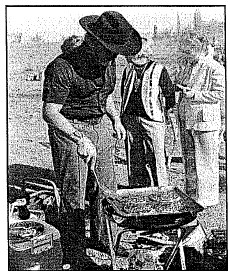
One of many events, which took place on the site of our new campus, was our annual outdoor worship service preceded by a cookout breakfast. It was cool but our hearts were warmed as our faith imagined the buildings that would keep us for years to come.
Three personal events highlight 1979 for me. I was elected President of the Fountain Hills Chamber of Commerce; Goldie Demeter was hired as Church Secretary; my wife, Betty, and I were separated. When I shared the latter experience with the Session, one of the elders, speaking for the whole said, “We’re sorry. But, if we can’t support you as you have supported us, we are not the Church.” This attitude reflects the character of this congregation. I am grateful.
By midsummer it became evident that we were running out of space for worship services. To solve the problem, the Session rented office space for our Church in unit one of the Enterprise Plaza, then tore down walls in our other rented building to expand the seating capacity. The arrangement worked well and lasted until after our move to our Campus.
I turned down the office of President of the Chamber for 1980 in favor of serving the Presbytery as Chair of the Committee on Ministry, a task I enjoyed for two years. I was able to use my skills in assisting “win — win” conclusions to conflicts in churches of the Presbytery with problems.
The congregation elected one of its most important committees this year, the Building Study Committee. The task was to assess the needs, wants and abilities of the congregation and determine what space was needed for our future. Jim Tibbetts was Chair with Ralph Bugg, Ben Fast, Peggy Gunn, Bob Offringa, Jack Schuler and Ann Stavely as members. Their report was adopted by the congregation in June of 1981 with two immediate recommendations. First, that we hold another capital funds drive for a Building Fund and second, elect a Building Committee.
The Campaign was held in November with good results. One of the interesting events was our Congregational Dinner, held at the Church of the Ascension (Catholic), with the meal being prepared and served by the women of the Shepherd of the Hills Lutheran Church. It was truly an ecumenical event and spoke clearly of our openness.
At a Congregational Meeting the Building Committee was elected, the members being: Dorothy Dillinger, Ben Fast, Don Federspiel, Milton Smith and Jim Tibbetts. This committee led us through a highly creative time of developing plans, securing financing and building our Campus.
Personally, 1981 brought a lady by the name of Joan Cole, into our Church and into my life. We were marred at Fountain Park by the Rev. Ralph Meredith on December 6, 1981, before a host of congregational members and friends.
Nineteen eighty-two seemed to be dominated with work toward our new buildings. By March the Building Committee selected Dean Glasco as our Architect, authorizing the firm to develop a site plan. Glasco, working closely with the Committee, presented to the congregation a Campus Plan at a special meeting in August. The congregation voted to, “Authorize the Building Committee and Architect to prepare construction documents, working drawings and proceed with bidding.” All of this was done with the good cooperation of the Presbytery.
While this was being done, the Building Committee was working on a financial plan that included application for a $175,000 loan from the denomination and a commercial loan of $275,000 from a baulk. Our Church is greatly indebted to Ben Fast and Don Federspiel for their creativity in arranging these loans. One factor in the financial plan was a gift to our Church from a nonmember Herman Glasby, that resulted in our ownership of part of the proceeds of an Oklahoma oil well. We still are receiving proceeds from that gift. It was sad that the day we received final confirmation of the gift, Mr. Glasby died of a sudden heart attack. Incidentally, Herman’s ashes are in an urn in the Memorial Tower.
It was into 1983 before bidding took place and a contract was signed with Robert Mann Construction Company to build our campus. Ground breaking took place on Sunday, March 20. Work began the next day. Construction was halted for a few weeks when Milt Smith, the Committee’s site inspector, discovered a delivery of the wrong block. Much of the perfection in our buildings is due to Milt’s careful and critical eye.
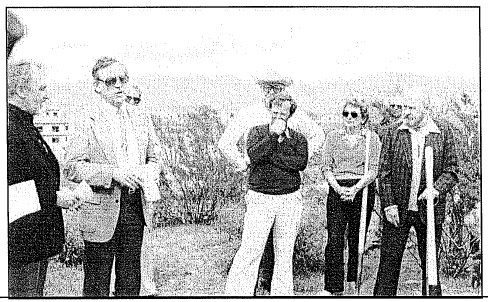
Left to right: Glenn Atchinson. Dean Glasco, Robert Mann, Ben Fast, Don Federspiel, Dorothy Dillinger, Jim Tibbetts.
One of the fascinating stories that goes with the construction concerns THE CACTUS. There was a beautiful saguaro cactus in the middle of our site. The building committee instructed the architect to place buildings so as not to disturb its place. The building contract stated that the saguaro was to be protected from damage during construction. All this was done. However, a few weeks before we moved into the Sanctuary the cactus was struck by lightning and fell to the ground. “The best laid plans of men and mice …”
In the meantime, the congregation was dealing with one of my “great ideas” which was to rename our Church. I proposed it be named CHURCH OF HOPE — Presbyterian Church USA. After several meetings of the congregation, it was voted to change the name from “The Presbyterian Church in Fountain Hills” to” Fountain Hills Presbyterian Church.” You win some and you lose some.
The congregation moved into the Sanctuary for a first Worship Celebration on December 18, 1983. What a wonderful day! As one might expect, something went wrong. The sewers clogged up and the toilets couldn’t be used. They were soon fixed. Everything else was just great, with a full house of enthusiastic members. I am convinced the reason for a successful building project was a small committee of exceptional talent that made all the decisions. I preach this whenever I have a chance to talk to others about doing projects.

First Sunday in New Sanctuary – December 18, 1983
Slight confusion rained as 1984 opened. We were in the new Sanctuary but the office building and education room was still unfinished. Therefore, we were still using the old Enterprise Plaza office space and using our old rented building for Pre-School and Sunday School. Early in March we moved the office and Sunday School to our Campus but left the Pre-School in the old rented space. At the end of the spring session, Christ’s Church took over our former location and the Pre-School.
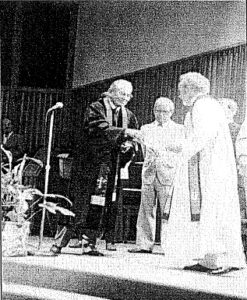
Right to left: Dr. Roe Lewis, Robert Mann, Pastor Glenn Atchinson, Building Chair, Ben Fast.
The congregation held a community Open House at our new Campus on March 18 as the opening of a week-long celebration leading to a Dedication Service on March 25, almost 10 years to the day of our first service in Fountain Hills. The Rev. Roe Lewis, a retired Native American Presbyterian clergy, gave the dedication message. He was chosen to speak because we wanted one who understood the tasks of the church as well as one who held sacred the good earth. He offered a blessing for our enhancement of the earth by the structures we placed upon it.
On one of the Sunday in January, I witnessed a car come into our parking lot, look for a place to park and, finding none, drive away. The Session tools immediate action and added more parking at the front of our landscaping, thanks to members who offered to pay for parking spaces. The Presbytery Committee needing to approve the project failed to do so. I called the Chair of the Committee to insist she get approval that day. She did. What I didn’t tell her was the equipment was already working on the project.
My personal agenda was not good. After a brief stay in the hospital I was told by my Doctors to take some time off from work. I was away from my duties half of May, all of June and July. Our Church continued to function smoothly due in a great part to the excellent leadership of our Corporation President Elder Don Krug, and the work of the Session and our Secretary, Goldie Demeter.
As soon as our buildings were dedicated, it was time for a Pledge for Progress — Phase III finance campaign for debt retirement. Though it is not nearly as exciting to pay off debts as it is to arrange for them, this campaign was a success. The highlight was the congregational dinner to kick off the campaign. It was held in the Narthex, jam-packed with 120 members and friends. The dinner committee accomplished this by having a “Circus” theme, complete with balloons, peanuts, hot dogs, potato chips, and soft drinks, all served by clowns. One expects noise and crowding at a circus so everyone enjoyed the event.
The Civic Association, in our community, began to use our Sanctuary for the Community Concerts in 1985. Performers soon recognized the room had the best acoustics of any place in the valley and enjoyed being there. The Civic Association eventually moved their grand piano into our Sanctuary for our use between concerts. It remained with us until the purchase of our own Grand several years later.
This was also the year our educational leaders created the innovative after school program for children, called Wacky Wednesday. Joan Atchinson and Nancy Green were the leaders. It was discontinued the following year when the school district moved to staggered class sessions, making it impossible to schedule this event.
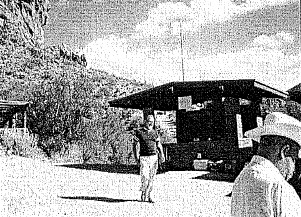 The first of two Superstition Weekends was held in November at the Don’s Camp in the Superstition Mountains. Joan Atchinson chaired the committee and, with Jan Alvin, directed the thee-day retreat of fun, inspiration and relaxation.
The first of two Superstition Weekends was held in November at the Don’s Camp in the Superstition Mountains. Joan Atchinson chaired the committee and, with Jan Alvin, directed the thee-day retreat of fun, inspiration and relaxation.
In 1986 our congregation was elected to send a commissioner to General Assembly and the Session selected Elder Jack Schuler to attend. The Assembly was held in Minneapolis. During our Sunday Worship Celebration Jack called and gave a report to the congregation over the sound system so all could hear.
Though it took a few years to accomplish the tasks, 1986 was the year the congregation approved the development of plans to increase our facilities to meet the demands of our growing congregation. These included the building of a Program Center, a nursery and classrooms. The Columbarium was considered as well as additional parking. Our Architect, Dean Glasco, again was our consultant and designer. Preliminary plans were adopted at the Annual Congregational Meeting in January of 1987, along with approval to call an associate pastor.
In February of 1987, Joan and I headed a tour to the Holy Land and Egypt. I had traveled to the Holy Land the year before, but this time there were 15 persons from our congregation plus two from The Church of The Ascension, including my good friend, Fr. Paul. It was a journey of a lifetime that will live forever in our memories. Later that year Fr. Paul had a fatal heart attack. I was so happy that I had arranged for him to say Mass in the Holy Land, a dream of his fulfilled.
This was the year that our Church entered the computer age. A research committee studied our needs and determined it was time to computerize our membership and finance record. Joan Atchinson was hired to recommend the hardware and software and to do the transition from paper records to computer records.
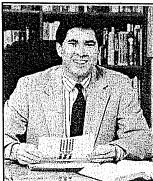 The Associate Pastor Nominating Committee recommended to the congregation the call of the Rev. Steven Frazier and the congregation concurred. Steve began his ministry with our Church in September and was ordained and installed on October 25, 1987. This signaled the Church’s commitment to provide programs that would meet the needs of children, youth and young families.
The Associate Pastor Nominating Committee recommended to the congregation the call of the Rev. Steven Frazier and the congregation concurred. Steve began his ministry with our Church in September and was ordained and installed on October 25, 1987. This signaled the Church’s commitment to provide programs that would meet the needs of children, youth and young families.
In the early years of our congregational life the women of our Church declined to form a traditional Presbyterian Woman’s Organization. More informal groups met for social and spiritual events, the main one being the “After 5” group. In 1988 this group gave way to “The Council on Woman’s Ministries” which coordinated activities such as Bible Studies, Book Studies, a Hiking Group (that did the Grand Canyon) and Mission Project groups. In 1997 our Church finally formed a Presbyterian Woman’s group that tools over the leadership of all ministries with and for women.
During this exciting time, the Session struggled to find the right design for the Program Center, the Columbarium and to find a financial plan to see all this accomplished. After many hours of investigation and selling our projects to lending institutions, Community Bank restructured our debt and loaned the Church the funds to proceed with the construction of the Program Center, thanks to a large extent to Marvin Puryear and his committee. Construction began in January of 1989 on the Center. We all celebrated the event with a “slab party” after the concrete floor was poured. This congregation always finds an occasion to celebrate!
Our Support Campaign 1989 was less than successful and the Session was ready to cut salaries and programs to match our expected income. My response was, instead of cutting to match what is expected, let’s create an opportunity to have more income. The plan was to raise $40,000 in one week in March. It was not a total success. We only raised $33,000! But that was enough to keep all staff and programs intact. I still have people say to me, “I was there when you raised more than $30,000 in one week. I never saw anything like it!” This congregation has always been able to do what it wills to do.
The big frustration was the Columbarium. The county required a special use permit and one of the two adjacent landowners wouldn’t sign. After several special hearings, the use permit was granted and, as a result of our efforts, the county dropped that requirement for all other churches wanting a columbarium on church property. However, our problems weren’t over yet. The cost of the facility, to be built to the rear of our property, exceeded $90,000. Again God gave me a better idea that I submitted to the committee. “Let’s move the Columbarium from the rear of our property to the space in front of the Tower!” The committee liked it; the architect liked it; the Session liked it; the congregation liked it; and so it was done. In choosing this plan, the cost was reduced by two thirds. God often has a better plan if we will only listen for it.
Joan and I had the pleasure of leading another tour group from our Church in 1989. This one was a Presbyterian Heritage Tour to England and Scotland. The ten days were not only informative but also great fun with this family of the congregation. We will never forget it.
In September of 1989 the Program Center was ready for use and was dedicated following a Worship Celebration Service. The youth and› children’s programs increased dramatically in numbers, validating the correctness of the investment. Steve Frazier and the education leaders were creative in the use of both space a time. 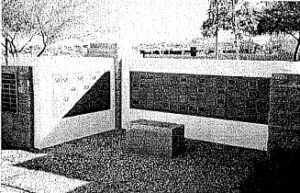
The Columbarium was completed and dedicated. Along with this addition came a gift from Thomas Taylor which allowed us to install the Carillon system in the Memorial Tower. These were wonderful additions to the total ministry of our Church and the community of Fountain Hills.
In light of Joan Atchinson’s work in computerizing our Church and her skills as an accountant, a Session committee recommended she be hired as our Church Administrator. However, the Session, led by a group of members who were upset at me, voted no. Joan resigned her temporary position with the Church but she continued to be the consultant and troubleshooter for the accounting and computer system. Folks, I still think this was a spiteful mistake.
Nineteen ninety was very eventful for me personally. I became the Moderator of the Presbytery of Grand Canyon and was elected by the Presbytery as a commissioner to the General Assembly in Salt Lake City. I gave myself to the denomination that year, while seeing our Church grow rapidly in membership. Parking was still a problem. John Wyman, our buildings and grounds chair on the Session, worked to add “landscaping” granite that could also be used for parking. It added 20 more spaces.
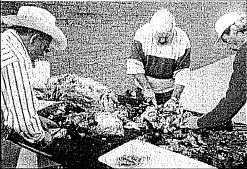
Bill Quigley, Tony Saladino & Chuck Green
The Church celebrated its 17th birthday by holding a three-day “Homecoming” in November, complete with an “tin talent” show, pig roast and dance in the courtyard. Scottish bagpipers greeted us at our Worship Celebration. I still have my Homecoming coffee mug, a gift given to all who attended Worship on that Sunday.
One of the great joys in 1991 was Session’s recommendation to the Presbytery for Kathy Pyke to be taken under care in her process to become an ordained minister. That she did. She was ordained in front of our congregation on February 18, 1996 and is co-pastor, with her husband, Richard, at a Presbyterian Church in Albuquerque. One of the great moments at her ordination was Donna Hansen coming forward at the laying on of hands. It was Donna who first invited Kathy to attend our Church with her. See what can happen when we extend a simple invitation to a neighbor to “come and see?!
One Sunday in 1991, I was standing in the Narthex waiting for the service to begin when one of our winter visitors asked if the piano in use belonged to our Church. I told him how it was on loan to us from the Civic Association. “How would you like a new one?” he asked. “I think that would be great! Do you want to contribute to a fund for one?” “Maybe I will pay for it, if you get the right one,” he responded. As the prelude began, I said, “I’ll think about it and get back to you. But you do make the adrenaline run!”
Within two weeks the Steinway Grand Piano was on the Chancel, a gift from Stan and Myrene Petitpren, given as a tribute to our excellence in music ministries and in honor of our long-time pianist, Dorothy Parris.
Having been with us since 1987, Steven Frazier requested his relationship with our Church be dissolved in January of 1992, so he could accept a position as Pastor of a church in Virginia. We celebrated his ministry in our Church and bid him farewell and God’s speed as he progressed in his vocation. To fill our needs, Richard Pyke was hired as part-time Interim Associate Pastor from February through June, when he and Kathy left for her seminary studies. To meet the staffing needs, the Session adopted a plan with part-time staff members. Nick Davis was hired as Youth Worker, Shelley Spencer as Children’s Worker and later in the year, the Rev. Leonard Engstrom was hired as Parish Associate.
Nineteen ninety three was my year, again. “Cancer!”, they said. So following in the footsteps of my Father and older brothers, I underwent surgery that has proven to be successful. It did slow me down, but not for too long.
In June, Nick needed to resign because of his secular world load and Shelley was asked to step aside so the Session could hire Pat Bennier as full-time Assistant to the Pastor for Program Management, a position she still holds.
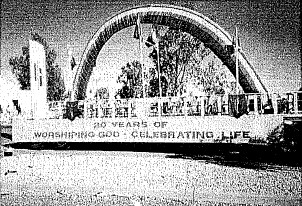 “A Year of Celebration” was declared in 1994 as our Church celebrated 20th anniversary. Some of the highlights of the years were the “Bar Stool Brunches” held after Worship at Que Bueno Restaurant, the building in which we first met as a new Church Development; the building of a Classroom addition to the Program Center, (built with cash) and a huge dedication party on November 27, the anniversary of the chartering of our congregation. The year of celebration ended with fireworks in the Church yard. This congregation really knows how to do it up right!
“A Year of Celebration” was declared in 1994 as our Church celebrated 20th anniversary. Some of the highlights of the years were the “Bar Stool Brunches” held after Worship at Que Bueno Restaurant, the building in which we first met as a new Church Development; the building of a Classroom addition to the Program Center, (built with cash) and a huge dedication party on November 27, the anniversary of the chartering of our congregation. The year of celebration ended with fireworks in the Church yard. This congregation really knows how to do it up right!
Parking was again on the agenda in 1995. Thanks to the leadership of Bill Flaherty, who was volunteer project manager, and Bill Bennier (Pat’s husband), who managed the concrete, the additional parking was completed on time and under budget words seldom heard.
Toward the end of 1995 I was approached by a nonmember wishing to donate funds for a new Allan Organ for our Church in memory of his sisters. The gift was $50,000, all to be used for the organ project. Jim Bates was volunteered to oversee the installation in early 1996 and the new organ was joyously dedicated on March 31, of that year. We really have been blessed with wonderful donations from people who really believe in what our Church is doing. Such gifts have made a significant difference in this ministry.
In February of 1996, the Session held a meeting with our Presbytery Executive and the Chair of the Presbytery Committee on Ministry to talk about staffing plans for before and after my retirement. Following a Session Retreat, it was decided not to renew Leonard Engstrom’s contract and to seek an Associate Pastor who would remain after my retirement to provide a continuity in pastoral leadership. The congregation approved and a search committee was elected for the task.
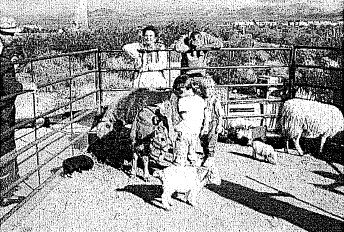 Our children led the entire congregation in a great mission project to raise $8,000 for Heifer International to purchase animals for needy families. Thanks to a “Living Market,” held in November, complete with a live animal petting arena, and the efforts of the “White Elephant” parking lot sale, headed by Blanche Brisbane, the goal was only short by $300 by the middle of 1997. During announcements one Sunday, the bright idea to auction off the paper Mache cow used to collect coins at the entrance to the Sanctuary. It went to Jerry Miles for $300, thus completing the project. At a retirement picnic Jerry presented me a plaque with the head of this heifer mounted on it, a “trophy of ministry.”
Our children led the entire congregation in a great mission project to raise $8,000 for Heifer International to purchase animals for needy families. Thanks to a “Living Market,” held in November, complete with a live animal petting arena, and the efforts of the “White Elephant” parking lot sale, headed by Blanche Brisbane, the goal was only short by $300 by the middle of 1997. During announcements one Sunday, the bright idea to auction off the paper Mache cow used to collect coins at the entrance to the Sanctuary. It went to Jerry Miles for $300, thus completing the project. At a retirement picnic Jerry presented me a plaque with the head of this heifer mounted on it, a “trophy of ministry.”
By the middle of 1997 it became apparent that the search for an associate pastor was unsuccessful, due largely to the coming retirement of the Senior Pastor. The Session shifted gears and contracted with the Rev. Gary Kush to work Part-time in the ministries of our Church. His leadership in adult education brought the highest attendance in the history of our Church and his preaching has been inspirational as well as educational. Personally, I have not worked with a more compatible colleague in the ministry.
After consultation with my family, my Doctor and the Interim Presbytery Executive, I announced my intention to retire at the end of June 1998. The Session and congregation concurred with this decision. The final year, 1998, was filled with the events, administratively, socially and emotionally, putting our Church in the best possible position to go through the transition from one Pastoral Leader to another.
I have been asked to say a few words about the traditions and style of this congregation. It has often been said that this is a non-traditional Church. Not so! There are some deep traditions that our people count on, such as, holding hands during the Lord’s Prayer, singing “Shalom Chaverim” for the benediction, the Maundy Thursday Service, and the Christmas Eve Services. Almost everything else is up for grabs, depending on the meaning intended for any one event.
“I was a traditionalist when we moved here,” commented a long-time member. “But now I am convinced there are better ways of doing things.” My reply: “I was a traditionalist when I came here, too. But listening to the people who moved to Fountain Hills and to this Church I learned that this would not be meaningful. I did not intended to be create a style. The style evolved out of seeking to be meaningful and relevant, creating each service or event to it touched lives in the here and now.”
The secret to the future success of this Church is to listen to the needs and wants of the people who come to be the family of God in this place and respond with meaning and quality. May this always be the ever changing style of the Fountain Hills Presbyterian Church.
The rest of this history will have to be “as you see it.” My retirement looms before me as a wonderful challenge to continue being my best, to enjoy life with celebration, and to be a servant of God wherever I may be.
These pages leave so much of our history together unsaid. Only highlights of years are presented because of the impressions made on us all by the events. The rest you will find in the minutes of the Session and in the hearts and minds of the people who have made our Church what it is today.
In ending I need to say these years have been the most productive of my very productive life in pastoral ministry. If it was all planned out, it was by a bigger mind than mine. I didn’t plan it, but I wouldn’t change it either. May God continue to bless us all.
Much love,
Glenn A. Atchinson June 1998
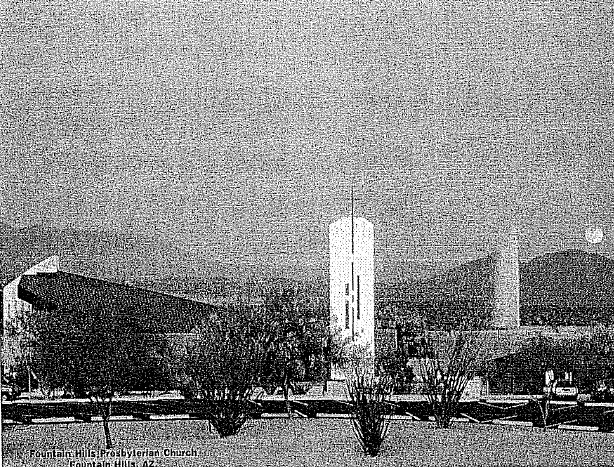
 The first challenge was to find a meeting place. There were no buildings available even if we had the money to rent one. Dick Hartley and I visited the owner of Little John’s, a bar/restaurant recently opened, and asked if we might use the place for services on Sunday mornings. Tom Colosimo, the owner, not only agreed but offered it free of cost, including his coffee.
The first challenge was to find a meeting place. There were no buildings available even if we had the money to rent one. Dick Hartley and I visited the owner of Little John’s, a bar/restaurant recently opened, and asked if we might use the place for services on Sunday mornings. Tom Colosimo, the owner, not only agreed but offered it free of cost, including his coffee. Music was from tapes which I had made at various Churches in the Valley.
Music was from tapes which I had made at various Churches in the Valley. September revealed that Little John’s was too small for our gatherings. The group, led by Larry Ryerson, an early member of the fellowship, negotiated a lease agreement for our exclusive use of a 2,500 square foot building on Enterprise Drive. After renovations, completed by the people of the fellowship, the new church development moved into the space on the first Sunday of October, World Communion Sunday. Our Church remained there until moving to our Campus in 1983.
September revealed that Little John’s was too small for our gatherings. The group, led by Larry Ryerson, an early member of the fellowship, negotiated a lease agreement for our exclusive use of a 2,500 square foot building on Enterprise Drive. After renovations, completed by the people of the fellowship, the new church development moved into the space on the first Sunday of October, World Communion Sunday. Our Church remained there until moving to our Campus in 1983.
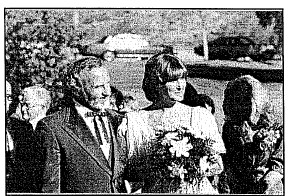




 The first of two Superstition Weekends was held in November at the Don’s Camp in the Superstition Mountains. Joan Atchinson chaired the committee and, with Jan Alvin, directed the thee-day retreat of fun, inspiration and relaxation.
The first of two Superstition Weekends was held in November at the Don’s Camp in the Superstition Mountains. Joan Atchinson chaired the committee and, with Jan Alvin, directed the thee-day retreat of fun, inspiration and relaxation. The Associate Pastor Nominating Committee recommended to the congregation the call of the Rev. Steven Frazier and the congregation concurred. Steve began his ministry with our Church in September and was ordained and installed on October 25, 1987. This signaled the Church’s commitment to provide programs that would meet the needs of children, youth and young families.
The Associate Pastor Nominating Committee recommended to the congregation the call of the Rev. Steven Frazier and the congregation concurred. Steve began his ministry with our Church in September and was ordained and installed on October 25, 1987. This signaled the Church’s commitment to provide programs that would meet the needs of children, youth and young families.

 “A Year of Celebration” was declared in 1994 as our Church celebrated 20th anniversary. Some of the highlights of the years were the “Bar Stool Brunches” held after Worship at Que Bueno Restaurant, the building in which we first met as a new Church Development; the building of a Classroom addition to the Program Center, (built with cash) and a huge dedication party on November 27, the anniversary of the chartering of our congregation. The year of celebration ended with fireworks in the Church yard. This congregation really knows how to do it up right!
“A Year of Celebration” was declared in 1994 as our Church celebrated 20th anniversary. Some of the highlights of the years were the “Bar Stool Brunches” held after Worship at Que Bueno Restaurant, the building in which we first met as a new Church Development; the building of a Classroom addition to the Program Center, (built with cash) and a huge dedication party on November 27, the anniversary of the chartering of our congregation. The year of celebration ended with fireworks in the Church yard. This congregation really knows how to do it up right! Our children led the entire congregation in a great mission project to raise $8,000 for Heifer International to purchase animals for needy families. Thanks to a “Living Market,” held in November, complete with a live animal petting arena, and the efforts of the “White Elephant” parking lot sale, headed by Blanche Brisbane, the goal was only short by $300 by the middle of 1997. During announcements one Sunday, the bright idea to auction off the paper Mache cow used to collect coins at the entrance to the Sanctuary. It went to Jerry Miles for $300, thus completing the project. At a retirement picnic Jerry presented me a plaque with the head of this heifer mounted on it, a “trophy of ministry.”
Our children led the entire congregation in a great mission project to raise $8,000 for Heifer International to purchase animals for needy families. Thanks to a “Living Market,” held in November, complete with a live animal petting arena, and the efforts of the “White Elephant” parking lot sale, headed by Blanche Brisbane, the goal was only short by $300 by the middle of 1997. During announcements one Sunday, the bright idea to auction off the paper Mache cow used to collect coins at the entrance to the Sanctuary. It went to Jerry Miles for $300, thus completing the project. At a retirement picnic Jerry presented me a plaque with the head of this heifer mounted on it, a “trophy of ministry.”